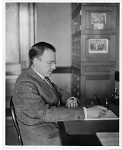
http://siarchives.si.edu/collections/siris_arc_296547
Dellinger effect, a fadeout of short-wave radios caused by solar flares, is first reported by J. H. Dellinger in 1935, as sudden disturbances of the ionosphere.
The figure is from his paper, “The Role of the Ionosphere in Radio Wave Propagation”, AIEE Transactions, 1939, Vol. 58.
http://ieeexplore.ieee.org/stamp/stamp.jsp?tp=&arnumber=6431636
Interestingly enough, at that time the layers E and F, the latter becomes F1 and F2 in the daytime, were well known, but not the D layer. In his another paper, “Sudden Disturbances of the Ionosphere”, Proc. of the IRE, October 1937, he writes:
It may, therefore, be concluded that these sudden disturbances involve a sudden great increase of ionization in some region through which radio waves pass on the way to being reflected by a higher region. Since the fade-out occurs in radio waves reflected by the E as well as the higher layers, the absorbing medium must be below the E layer…
This low layer may perhaps be called the D layer, but not enough is yet known about it to be sure that this designation is appropriate.
He also says in the same paper that:
The effect was discovered in 1935, and found to occur simultaneously everywhere throughout the illuminated half of the globe but not in the night half…
The radio and magnetic effects are of maximum intensity in that region of the earth where the sun’s radiation is perpendicular. Many of the occurrences are simultaneous with great eruptions on the sun. Such eruptions emit vast quantities of ultraviolet light. These radiations are sometimes of such frequencies as to cause intense ionization of part of the ionosphere below the E layer.

